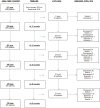Impact of injection frequency on 5-year real-world visual acuity outcomes of aflibercept therapy for neovascular age-related macular degeneration
- PMID: 32265509
- PMCID: PMC8026582
- DOI: 10.1038/s41433-020-0851-y
Impact of injection frequency on 5-year real-world visual acuity outcomes of aflibercept therapy for neovascular age-related macular degeneration
Abstract
Background: To evaluate the impact of injection frequency on yearly visual outcomes of patients treated with intravitreal aflibercept for neovascular age-related macular degeneration (nAMD) over a period of 5 years in a tertiary ophthalmic centre.
Design: Single centre, retrospective cohort study.
Participants: Consecutive treatment-naive nAMD patients initiated on aflibercept injections 5 years ago.
Methods: The Moorfields OpenEyes database was searched for consecutive patients who were initiated on intravitreal aflibercept for nAMD in 2013-14 and the visual acuity (VA) in Early Diabetic Retinopathy Study (ETDRS) letters and injection records per year were recorded for a period of 5 years. Analyses of the whole cohort and a sub-sample of 5-year completers were done. The cohort was further grouped into Group A (on continuous treatment), Group B (early cessation of treatment) and Group C (interrupted treatment) to evaluate the relation between treatment frequency and visual outcomes.
Main outcome measures: The primary end point was change in VA at 5 years; secondary outcomes included proportion of eyes that gained or maintained VA, number of injections received and the effect of treatment frequency.
Results: Data were collected on 468 patients (512 eyes). Sixty-six percent of the patients completed 5-year follow-up. The mean age of the whole cohort was 79.5 ± 8.5 years and the mean baseline VA was 58.3 ± 15.4 letters. Amongst the completers, final VA change was -2.9 (SD 23.4) ETDRS letters and the cumulative number of injections over 5 years was 24.2 (10.6). Group A had three letter gain and received significantly higher cumulative number of injections over 5 years than Group B and C (31.8, 14.6 and 18.4 respectively, p = 0.001). After adjusting for age and baseline VA, on average, final VA was +8.0 letters higher in the ≥20 injections group than the <20 group (p = 0.001).
Conclusions: Aflibercept therapy results in sustained good visual outcome over 5 years in neovascular AMD eyes when early and persistent treatment is given.
Conflict of interest statement
SS has received research grants, attended advisory board meetings and received honorarium from Bayer, Allergan, Novartis, Roche, Boehringer Ingleheim, Heidelberg Engineering, Optos, Apellis, Ophtea, Oxurion.
Figures


References
Publication types
MeSH terms
Substances
LinkOut - more resources
Full Text Sources

